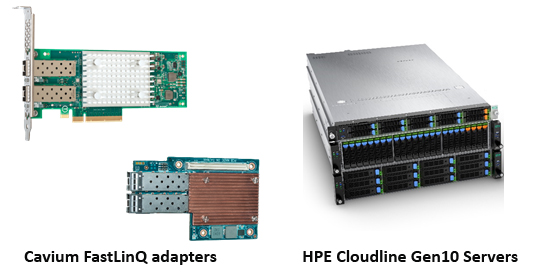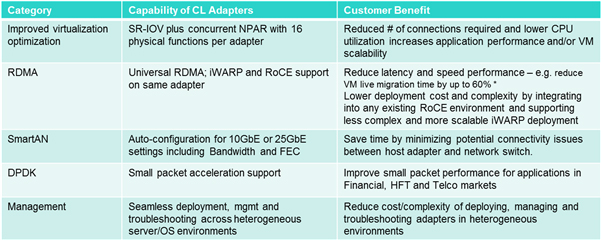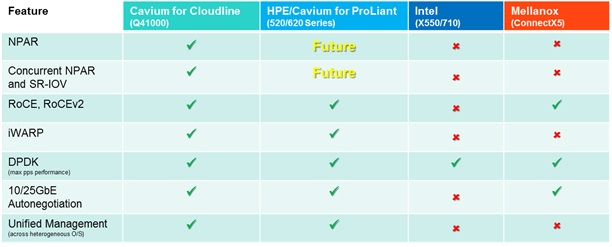Posts Tagged 'HPE Cloudline Servers'
-
2018年5月2日
Cavium FastLinQイーサネット・アダプタがHPE Cloudlineサーバーで使用可能に
By Todd Owens, Field Marketing Director, Marvell
Are you considering deploying HPE Cloudline servers in your hyper-scale environment? If you are, be aware that HPE now offers select Cavium ™ FastLinQ® 10GbE and 10/25GbE Adapters as options for HPE Cloudline CL2100, CL2200 and CL3150 Gen 10 Servers. The adapters supported on the HPE Cloudline servers are shown in table 1 below.
Table 1: Cavium FastLinQ 10GbE and 10/25GbE Adapters for HPE Cloudline Servers
As today’s hyper-scale environments grow, the Ethernet I/O needs go well beyond providing basic L2 NIC connectivity. Faster processors, increase in scale, high performance NVMe and SSD storage and the need for better performance and lower latency have started to shift some of the performance bottlenecks from servers and storage to the network itself. That means architects of these environments need to rethink connectivity options.
While HPE already have some good I/O offerings for Cloudline from other vendors, having Cavium FastLinQ adapters in the portfolio increases the I/O features and capabilities available. Advanced features like Universal RDMA, SmartAN™, DPDK, NPAR and SR-IOV from Cavium, allow architects to design more flexible and scalable hyper-scale environments.
Cavium’s advanced feature set provides offload technologies that shift the burden of managing the I/O from the O/S and CPU to the adapter itself. Some of the benefits of offloading I/O tasks include:
- Lower CPU utilization to free up resources for applications or more VM scalability
- Accelerate processing of small-packet I/O with DPDK
- Save time by automating adapter connectivity between 10GbE and 25GbE
- Reduced latency through direct memory access for I/O transactions to increase performance
- Network isolation and QoS at the VM level to improve VM application performance
- Reduce TCO with heterogeneous management
To deliver these benefits, customers can take advantage of some or all the advanced features in the Cavium FastLinQ Ethernet adapters for HPE Cloudline. Here’s a list of some of the technologies available in these adapters.
* Source; Demartek findings
Table 2: Advanced Features in Cavium FastLinQ Adapters for HPE CloudlineNetwork Partitioning (NPAR) virtualizes the physical port into eight virtual functions on the PCIe bus. This makes a dual port adapter appear to the host O/S as if it were eight individual NICs. Furthermore, the bandwidth of each virtual function can be fine-tuned in increments of 500Mbps, providing full Quality of Service on each connection. SR-IOV is an additional virtualization offload these adapters support that moves management of VM to VM traffic from the host hypervisor to the adapter. This frees up CPU resources and reduces VM to VM latency.
Remote Direct Memory Access (RDMA) is an offload that routes I/O traffic directly from the adapter to the host memory. This bypasses the O/S kernel and can improve performance by reducing latency. The Cavium adapters support what is called Universal RDMA, which is the ability to support both RoCEv2 and iWARP protocols concurrently. This provides network administrators more flexibility and choice for low latency solutions built with HPE Cloudline servers.
SmartAN is a Cavium technology available on the 10/25GbE adapters that addresses issues related to bandwidth matching and the need for Forward Error Correction (FEC) when switching between 10Gbe and 25GbE connections. For 25GbE connections, either Reed Solomon FEC (RS-FEC) or Fire Code FEC (FC-FEC) is required to correct bit errors that occur at higher bandwidths. For the details behind SmartAN technology you can refer to the Marvell technology brief here.
Support for Data Plane Developer Kit (DPDK) offloads accelerate the processing of small packet I/O transmissions. This is especially important for applications in the Telco NFV and high-frequency trading environments.
For simplified management, Cavium provides a suite of utilities that allow for configuration and monitoring of the adapters that work across all the popular O/S environments including Microsoft Windows Server, VMware and Linux. Cavium’s unified management suite includes QCC GUI, CLI and v-Center plugins, as well as PowerShell Cmdlets for scripting configuration commands across multiple servers. Cavum’s unified management utilities can be downloaded from www.cavium.com .
Gen10 servers. Each of the Cavium adapters shown in table 1 support all of the capabilities noted above and are available in standup PCIe or OCP 2.0 form factors for use in the HPE Cloudline Gen10 Servers. One question you may have is how do these adapters compare to other offerings for Cloudline and those offered in HPE ProLiant servers? For that, we can look at the comparison chart here in table 3.
Table 3: Comparison of I/O Features by Ethernet Supplier
Given that Cloudline is targeted for hyper-scale service provider customers with large and complex networks, the Cavium FastLinQ Ethernet adapters for HPE Cloudline offer administrators much more capability and flexibility than other I/O offerings. If you are considering HPE Cloudline servers, then you should also consider Cavium FastLinQ as your I/O of choice.
最新の記事
- HashiCorp and Marvell: Teaming Up for Multi-Cloud Security Management
- Cryptomathic and Marvell: Enhancing Crypto Agility for the Cloud
- The Big, Hidden Problem with Encryption and How to Solve It
- Self-Destructing Encryption Keys and Static and Dynamic Entropy in One Chip
- Dual Use IP: Shortening Government Development Cycles from Two Years to Six Months





